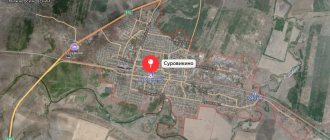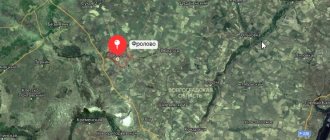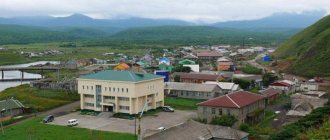| City of Tara, 2004 |
Tara
, a city in Russia, the administrative center of the Tara district of the Omsk region, the cathedral city of the Tara and Tyukalin diocese. Located on the left bank of the river. Irtysh, 285 km from the railway. Lyubinskaya station, 302 km north of Omsk. Road junction. Population - 27.6 thousand people (2012).
- On the map: Yandex.Map, Google map
The sixth city founded in Siberia.
The first Russian settlement on the territory of modern Omsk region. Founded in 1594 by governor Prince Andrei Vasilyevich Eletsky to protect the Upper Irtysh volosts from attacks by Khan Kuchum and the non-peaceful Tatars. The royal order to Prince Yeletsky said: “Go to the city and put it up the Irtysh on the Tara River, where it would be more profitable for the sovereign in the future, in order to establish arable land and exhaust the Tsar’s Kuchum and bring in salt...”
.
Having examined the mouth of the Tara River (hydronym Tara - from the Turkic tar
- “narrow”), Prince Yeletsky decided that the low, swampy lands on the river were not suitable for establishing arable land and were not convenient for building a city. The location was chosen on the high left bank of the Irtysh near the Arkarka River. It was the most elevated territory, surrounded on the west by swampy, difficult-to-pass lowlands, on the south and north sides by ravines, and on the east by the floodplain of the Irtysh and Arkarka rivers.
However, there is a version according to which the city was originally built at the mouth of the Tara River (where Ust-Tara is now). Then, in 1669, after a fire or great flood, it was moved to its present location [1].
The city burned down almost completely at least five times (including in 1629 and 1658 and 1669 (?)) [2].
| Watercolor drawing of the city of Tara in 1734 (from the LORAN archives), from the site taragorod.ru |
During almost the entire 17th century, Tara was considered a border town with Dzungaria and the Kyrgyz nomads and was of great importance as a strategic point from which the Russians launched their expeditions to the foothills of the Altai and Central Asia.
At this time, a lively barter trade began in the city with Dzungaria, Bukhara and Tashkent. In 1697, the city was included in the department of the Tobolsk category, in 1708 it was assigned to the Siberian province, and from 1719 - to the Tobolsk province.
With the construction of the Omsk fortress in the 18th century, when the Siberian Highway passed south of Tara, the city lost its strategic and commercial importance.
Since 1782 - a district city of the Tobolsk region of the Tobolsk governorship (since 1796 - Tobolsk province).
The military stage road from Tobolsk to Tomsk passed through Tara.
In the early 1880s, in the district city of Tara, Tobolsk province, there were 6 Orthodox churches, a mosque, 952 houses, a district and parish school, a girls’ school, a postal station, and a prison castle. There were 2 lard factories, 1 soap factory, 6 candle factories, 5 tanneries, 1 distillery, 3 brick factories, 18 forges, and a steam flour mill.
| Tara. View from the bell tower of the Spasskaya Church, 1916. Photos from the personal archives of A.A. Zhirov, from the site taragorod.ru |
Trade fairs – Annunciation (from March 20 to May 20) and Ekaterininskaya (from November 24 to December 20) – gathered a lot of people.
They traded clothes, shoes, leather, fish, livestock and harness, furs (squirrel, fox, beaver, ermine). Among the crafts, silversmithing, blacksmithing and painting were developed. At this time, the city belonged “according to the satisfaction of its residents, to the best cities of the Tobolsk province” [3]. According to information from 1900, the city had a printing house, 2 photographs, a city pawnshop, a city public library, a telegraph, charitable institutions: a charity home for the poor (opened in 1882), a syrup feeding house of commerce for Councilor Ya.A. Nemchinov, a shelter for exiles (opened in 1890).
At the beginning of the century, in comparison with the cities located on the railway line, the importance of Tara fell.
From June 1918 to November 1919, troops of A.V. were stationed in Tara. Kolchak.
Modern Tara is the second largest regional center of the Omsk region. Here are a branch of the Omsk Television Plant; meat, butter, cheese and mill plants; fisheries, breweries, brick factories; shoe and clothing factories.
Statistics
- 1869 - 7091 people
- 1897 - 7220 people
- 1906 - 7.6 thousand people (of which 2.3 thousand were exiles)
- 1913 - 11.2 thousand people
- 1926 - 10.3 thousand people
- 1939 - 15.4 thousand people
- 1959 - 22.6 thousand people
- 1992 - 26 thousand people
- 2005 - 26.9 thousand people
Religion
Since 1620 - within the Siberian and Tobolsk diocese. In the early 1620s, Archbishop Cyprian established the Spassky Monastery and Pyatnitsky Convent in the city.
At the beginning of the 18th century, Tara became a refuge for the “most fanatical” Old Believers. The persecution of the schism aroused a whole uprising here, which resulted in cruel executions. After the rebellion was pacified, in 1722 the Old Believers were impaled “in droves.” At the beginning of the century, in the vicinity of the city there were several crosses without inscriptions and extensive mounds - the graves of those executed, and the inhabitants of Tara retained the nickname “Kolovichi”. [4]
In 1734, there were four churches in the city (Assumption Cathedral, Paraskevinskaya (Pyatnitskaya), Preobrazhenskaya, Nikolskaya).
On February 18, 1895, the city was included in the newly formed Omsk diocese.
Before the 1917 revolution, the city had 6 Orthodox churches and a mosque. There were a parish Spasskoe 3-grade school (opened in 1841) and a parish one-grade school, a parish one-grade school, and also a Mohammedan school.
| Tara. A copy of a postcard from the early 20th century with the now defunct Assumption, Pyatnitsky and St. Nicholas churches, from the site taragorod.ru |
Among the ancient shrines, the Tikhvin Icon of the Mother of God was kept in Tara, brought here in 1594 by the first governor, Prince Andrei Yeletsky.
Among church antiquities, historians mention the gilded [5] bells on the Church of the Kazan Icon of the Mother of God, donated to the temple by one of the parishioners - lovers of church splendor. In the 1930s, all the temples of Tara were demolished, except Spassky.
In September-November 1937, March 1938, executions of clergy and laity were carried out in the city (group cases - “Case of the c/r organization of clergy. Tara, 1937”, “Case of Archpriest P.I. Pavlinov et al., Omsk o., 1937”, “The case of priest K.F. Frolov and others. Kolosovsky district of the Omsk region. 1937”, “Kolosovskaya counter-revolutionary insurgent group”). The bodies of those shot were presumably buried in the quarries of a brick factory (now building No. 33, 35 on 11th line street) [6].
In 1978, a house of worship was opened in the city, which believers had been seeking since the 1940s.
In 1990, the Spassky Church (now the cathedral) was handed over to believers.
Since June 6, 2012, Tara has been the cathedral city of the Tara and Tyukalin diocese.
Monasteries
- Paraskeva Pyatnitsa (female) (removed)
- Savior of the Image Not Made by Hands (male) (ed.)
Temples
- Ascension of the Lord
- St. George the Victorious (rem.)
- Kazan Icon of the Mother of God (demolished)
- St. Nicholas the Wonderworker, cathedral (dismantled in 1938)
- Paraskeva Pyatnitsa (exploded in 1951)
- Savior Not Made by Hands, Cathedral
- Tikhvin Icon of the Mother of God, cemetery (demolished)
- Dormition of the Blessed Virgin Mary (demolished)
TARA: History and Modernity (Part I)
1994 marked the 400th anniversary of the founding of Tara, the oldest city in Siberia and the first Russian settlement in the Omsk region. For more than 300 years, Tara was the voivodeship and district center of the Middle Irtysh region. It has a wonderful history, many architectural monuments that are of interest to local historians, tourists and excursionists. TARA: History and Modernity ” is dedicated to this event.
I. ACCESSION OF SIBERIA
The historical campaign of the Cossack squad under the command of Ataman Ermak Timofeevich, which began in 1581, after a stubborn battle on the banks of the Irtysh near the Podchuvashsky Cape, ended in the victory of Ermak. After this victory, on September 26, 1582, the Cossack squad entered the capital of the Siberian Khanate, Kashlyk (aka Isker, Siberia). This day is considered the day of the annexation of Siberia to the Russian state. The vast, sparsely populated and completely free spaces allowed the peoples of Siberia arriving from Russia to settle on free lands and carry out agricultural and fishing colonization without constraining or displacing the aborigines. Ataman Ermak, as a true representative of the Russian people, began to pursue a friendly policy towards the local peoples. With the occupation of the capital of the Siberian Khanate of Kashlyk, representatives of the local tribes of the Khanty and Mansi, Tatar princes and Murzas began to come to Ermak with gifts and voluntarily recognize the power of the Russian Tsar, take an oath (in ancient terminology “to kiss the wool”), which said “to be under his the royal hand forever... and they will pay yasak to the sovereign all the years without transfer, and not to think or do any evil against the Russian people.”
In the summer of 1585 (according to other sources, 1584), Ermak and part of his squad made a trip up the Irtysh. The princes of Tebenda, Tashetkan and other yurts met Ermak with gifts and voluntarily entered into Russian citizenship. These and other facts of voluntary entry into the Russian state, Ermak’s reception of ambassadors from the Khanty and Mansi, calls for Russians to defend local peoples give reason to speak not about the conquest of Siberia by Russia, but about the voluntary annexation of most of its territories to Russia.
On the territory of the modern Omsk region, Ermak reached the mouth of the Shish River. To protect and govern local peoples, the Moscow government began building cities in Siberia. The town of Ob was built in 1585, and Tyumen in 1586. And in 1587 Tobolsk was founded, which for many years became the main city of Siberia.
II. PRINCE ELETSKY
In the last quarter of the 16th century, under Tsars Fyodor and Boris Godunov, active construction of fortresses began in Russia. To strengthen the defense against the Crimean Tatars in “southern Ukraine” the cities of Voronezh (1585), Orel, Livny, Samar (1586), Saratov (1590), Yelets (1592), Kursk (1596) were built. Participants in the Livonian War, familiar with German and Swedish fortifications, became the founders of new Russian cities. Among the builders of the fortifications, the Yeletskys, descendants of the Chernigov-Siversk princes, stood out. One of them, Vasily Ivanovich, became the governor of the border Rylsk.
III. TAPE BASE
The need arose to create new fortifications in Siberia. The fact is that Khan Kuchum continued to roam in the south of this vast region. His army ravaged local tribes and nationalities that recognized the power of the Russians. The Tatars complained and asked to protect them. That is why the Moscow authorities decided to erect a Russian city above Tobolsk in the center of the populous Ayalyn volost. The experienced builder Prince Andrei Vasilyevich Yeletsky was entrusted with leading the expedition. Later they wrote about the emergence of Tara: “its initial establishment was established to protect the Tatars living along the river from the raids of Khan Kuchum.”
From the end of 1593, a detachment began to form in Moscow and Kazan to build a new city on the Irtysh. In Siberia it was replenished with Tyumen and Tobolsk Cossacks, as well as local Tatars. In the spring of 1594, a detachment of 1540 people left Tobolsk. The royal order to Prince Yeletsky stated: “Go to build a city up the Irtysh on the Tara River, where it would be more profitable for the sovereign in the future, in order to establish arable land and exhaust Tsar Kuchum and create salt.”
The location for the city was planned at the mouth of the Tara River, which covered the yasak Tatars of the Ayalyn volost, but with the caveat that if that river did not have all the necessary conditions, then Yeletsky should choose another, more suitable place. “And having come to the Tara River, look for a place under the city where it would be suitable for a new city to be, then clear the place and build a city,” the order said. The site at the mouth of the Tara River “did not appeal to Prince Yeletsky due to its baseness and inconvenience.” The city was built on the banks of the Arkarka River, calling it “along the Tara River... as the city was originally supposed to be founded.”
The new location on Arkarka was more convenient. The river covered the city from the south. The Clean Swamp was approaching from the west. South of Arkarka there was another river, Ibeika, with high steep banks. Only in the north (towards Tobolsk) lay an elevated ridge with chernozem soil suitable for arable land.
The builders fulfilled the order: by the autumn of 1594 the main structures were erected. Like all Russian cities of the 15th-16th centuries, Tara consisted of two parts. A relatively small fortification was erected in the center - a city where the voivode's courtyard and the “sovereign treasury” were located. It was surrounded by a large, extensive fortification - a fort with residential buildings for service people and townspeople.
Both in the royal order and in other documents of the 16th-17th centuries, Tara is called a city. A mistake is made when Tara is called a fortress. The city is ranked higher than the fortress in the ranks of the XV-XVII centuries. The fortress has only a military defensive structure, but the city had fortifications and had administrative power over the surrounding area. Tara immediately became the voivodeship center.
The fort, which encircled the city in a semi-ring, had walls made of dense gorodens with a total length of 576 fathoms and three arshins. Within the walls of the fort there were eight towers - an octagonal one, two blind hexagonal ones - Pyatnitskaya and Vishnyakova, three blind ones - Vestovaya, Spasskaya and Knyazhina, as well as a fortress gate with a tower above them. The size of the towers is evidenced by the description of one tower: “The tower is an octagonal carriageway, tented, the width of the tower is 4 fathoms, 3 arshins, the height from the ground bridge to the first bridge is half two fathoms, and from the first bridge to the middle bridge it is half two fathoms, and from the middle bridge to the breaks is 4 arshins.” without a man, the height of the tent is 3 fathoms with a half-arshin.” If the given ancient measurements are translated into modern ones, this will result in the height of a five-story building.
Of the 1,500-strong detachment of Tara builders, the bulk had to leave by winter. It was recommended to leave 140 Tobolsk and Tyumen Cossacks and 50 carpenters in the new city, and it was also ordered that “Prince Ondrei himself should be in the city... and the priests, the gunners, and the archers, they would have courtyards in the city.” The Cossacks and archers who remained in the city were recommended to bring their wives and children to the new place in the fall or spring of 1595. These first families marked the beginning of the formation of the Russian population of the Middle Irtysh region.
IV. KUCHUM IS DESTROYED
The founder of Tara, Prince Andrey, was replaced by his brother Fyodor Yeletsky. He brought reinforcements from the Cossacks and Streltsy, having received the royal order: “Fight Kuchum, but protect yourself from him.” A detachment of Tara Cossacks made a campaign against the town of Tunus, where the enemy was hiding, but, as the chronicle reports, “Kuchum with a few Tatars and with their wives and children managed to escape to the Kalmyk border, between the lakes in strong places and lived secretly in dirty tricks against the Russians and yasachny greener." The Russians learned through the Tatars that Kuchum began to seek support from the Nagais. In order to block crossings across the Irtysh and prevent Kuchum from contacting the Nagais, an expedition was sent from Tara up the Irtysh. In the summer of 1596, a detachment of 112 people on 6 ships sailed “up the Irtysh 20 bottoms across the Om River to the Otchair, Cherpak and Otmas tract.” It can be considered that this was the first Russian expedition to the southern border of the present Omsk region.
The Moscow government, through Tara, tried to enter into peace negotiations with Kuchum and his supporters. Through the Tara Tatars, a letter from Tsar Feodor was sent to the steppe: “Sovereign Kuchuma wants to keep the Tsar under his hand, and to reward his son Ablagirim and his people with his royal salary.” After this appeal, the mother of Tsarevich Mametkula and a group of noble Tatars voluntarily came to Tara. All of them were sent to Moscow, “treated kindly at court,” and received high ranks. But the proud Kuchum rejected the peace proposal. As they reported from Tara, Kuchum replied: “I didn’t go to the sovereign according to the sovereign’s letter of my own free will, at which time I was completely whole, and there is no reason for me to go to the sovereign for a saber, but now I have become deaf and blind and without any stomach.” .
In August 1598, a message was received from Tatar spies that Kuchum was wandering on the Ob in the Ormen tract. As reported in the chronicle, a Tara detachment of 400 people under the command of Voeikov, “leaving his kosh on Lake Ike, went against King Kuchum in haste, day and night, and Kuchum descended on the Ob River above Chat in a meadow on Ormen” (near present-day Novosibirsk) . Here, on August 20, 1598, the last battle with Kuchum took place.
Thus, Tara completed the great task of defeating Khan Kuchum, begun by Ataman Ermak Timofeevich. The task assigned to Tara - “to oppress Tsar Kuchum” - was completed.
Author: Alexander KOLESNIKOV, Doctor of Historical Sciences, Professor.
Based on materials from the album “TARA - on the 400th anniversary of the founding of the city,” edited by N. Maslov, A. Oreshkov.
Historical coats of arms
Coat of arms of the city of Tara 1785
The coat of arms was approved on March 17, 1785.
Description: “In the upper half of the shield is the coat of arms of Tobolsk, below “in a green field is a gray ermine, as a sign of the abundance and special kindness of ermines in this district.”
Project of the coat of arms of the city of Tara 1865
The draft coat of arms was drawn up as part of the heraldic reform carried out by Köhne Bernhard Vasilievich.
Description: “Full ermine shield. In the free part is the coat of arms of the Tobolsk province. The shield is crowned with a silver tower crown with three teeth; two gold hammers, connected by an Alexander ribbon, are placed crosswise behind the shield.”











